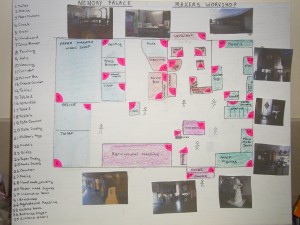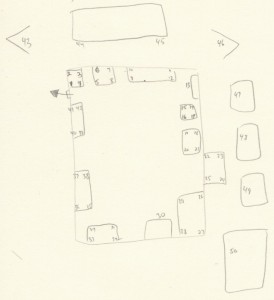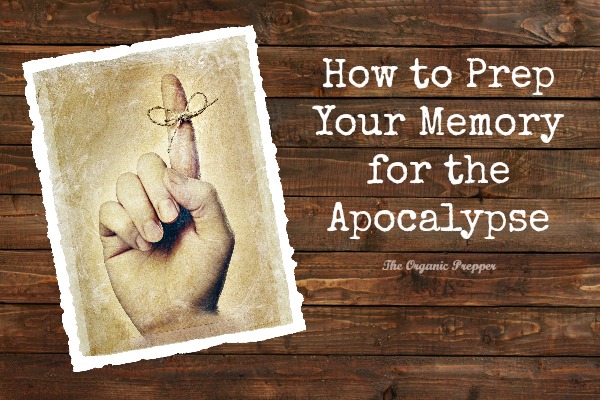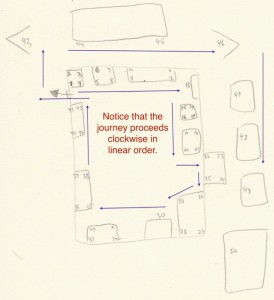If you're new here, you may want to subscribe to my RSS feed. Thanks for visiting!
Editor’s note: Dr. Metivier wrote the book on memory. Several of them. Literally. Did you ever stop to think about how critical your ability to memorize information is in the midst of a crisis? When he offered to write a post on memory strategies, I jumped at the chance to share this information with you. Following is an article that he wrote exclusively for readers of The Organic Prepper. Enjoy!
Guest post by Dr. Anthony Metivier of Magnetic Memory Method
There’s bad news and dark days on the horizon. But even though you may have a properly stocked pantry and more than enough know-how to keep your body alive … what about your mind?
And more specifically, what about your memory? How are you going to memorize names, faces, numbers, directions to shelters and even foreign languages you might need to understand when the world is coming down around your ears? Especially when you aren’t going to have a smartphone to do any of this for you?
It’s pretty simple. If you know how to use the raw power of your mind. But even the simplest garden requires preparation. And it’s not just about
stocking up on food essentials and first aid supplies. Before disaster strikes, you’re going to want to prepare your ability to memorize and recall critical
information.
And for troubled times, there are at least three kinds of memory you’ll want to prepare. The techniques you’ll learn in this post are linked by the same
principles, but can be approached differently depending on the situation.
The Power Of Memory Begins Apocalypse Now
The first kind of memory you’ll want to prepare is for pre-disaster. Like how about right now?
Now is when you devote enough time to learning and practicing memory techniques. Now is when you have the chance to lean heavily on the wealth of
things you already know and have easy access to in pop culture and news media. You’ll see what this means in a moment, but for now, you can relax if you feel you spend too much time watching junk TV. Believe it or not, fickle entertainments can serve us in incredibly powerful ways in the future when it comes to memory.
Train your memory and all those hours on the couch watching Breaking Bad can be like money in the bank.
Let This Strange And Beautiful Gift Protect You From The Tidal Wave
The second kind of memory involves having memory abilities on hand during the time of crisis. There will be a lot going on and the ability to quickly memorize information accurately and completely on the fly could mean the difference between life and death.
Memory Is A Powerful Torchlight For Marching Through The Darkest
Aftermath
Finally, there is post-crisis memory ability. This kind of memory will add to your safety. It will also keep your mind active in the absence of people and everything we’ve come to rely on for entertainment.
Luckily, there’s one specific memory technique that addresses all three of these crisis-based memory needs. So let’s get started.
Born From Crisis: The Best Memory Technique In The World
Everything you’re about to learn is harnessed to a principle of memory discovered thousands of years ago. This principle is location and draws upon our uncanny ability to recall places we’ve been. Even buildings from your childhood that you haven’t seen for decades can serve.
There are many versions of the story. The basics of the tale go like this.
Circa c. 556 – 468 BCE in Ancient Greece, Simonides of Ceos found himself at a banquet delivering a speech. It was in one of those incredible stone buildings with a roof that must have weighed hundreds of tons.
Good thing then that Castor and Pollux (two weird dudes) called him outside just before the building collapsed on top of everyone in attendance.
Simonides, who used memory techniques to give his speeches, was powerless to rescue anyone. But he was able to help families and officials identify the bodies in the rubble. Proper burials were conducted and closure found because Simonides knew not only the names of everyone in attendance. He knew exactly where in the building they had been.
Ever since then, people have been harnessing the power of location to memorize information.
Who Else Wants To Store Memories Without Relying On A Computer?
Have you ever said, “In the first place,” followed by a point you wanted to make? If so, you’re borrowing a convention from the ancient orators who structured their speeches around memory stations based on real locations.
Using these mentally created stations, the orators revisited them to decode special images. These images contained the content of their talks. And so when they got to the second station in their minds, they would start this section of their speech by saying, “and in the second place …”
These ancient memorizers created journeys between these stations of the mind, typically using what are now called Memory Palaces.
Many people are attracted to Memory Palaces – but usually far too late. As miraculous as these mental creations can be, they are one of those “dig your
wells before you’re thirsty” preparation activities. Whether it’s for a college exam or flat out war, you’ll want to spend some time learning how to use them for when disaster strikes.
So what is a Memory Palace anyway?
A Memory Palace is a mental construct based on a familiar location that you know intimately. Ideally, it will be based on a building so that the journey
between the stations is pre-structured. You can use outdoor locations as well, but this requires extra mental energy to maintain, which is not recommended.
We’ll talk more about preserving mental energy in what follows, but now it’s time to learn the best way to create a Memory Palace. While buildings still exist.
How To Quadruple The Value Of Your Real Estate – Even If It’s Been
Destroyed!
You can base a Memory Palace on any building, real or invented. Beginners are often taught to use their homes first, but a workplace, school, church, movie theatre or any building you can call to mind in relative detail will do. And by “call to mind,” we’re not talking about HDTV. Trying to make the image that clear is a trap. For example, a lot of people wind up trying to imagine every inch of rug and the subtle shade of eggshell white on the walls.
Unless you’ve got a monopoly on time and really enjoy recreating the minutia of the buildings you choose, focus on the layout of the building itself. Imagine a floorplan from a bird’s eye view and focus on the rooms and their corners. And if you want to get started right now, go ahead and get a pen or pencil and some paper. Because once you’ve got a building in mind, it’s time to create something like this:
[one_third_first][thrive_text_block color=”teal” headline=””]
numbered version of the journey. These numbers represent stations. In Memory Palaces, stations are particular places you leave information you’ve encoded with images to make it more
memorable.
There are two kinds of stations:
1) Micro-stations
2) Macro-stations[/thrive_text_block].[/two_third_last]
Micro-stations are spots inside of rooms: chairs, tables, fridges, beds, etc. Macro-stations are entire rooms. These are the kinds of stations you see in the illustration above. This kind of Memory Palace is ideal for beginners
The next illustration shows you a Memory Palace with a micro-station journey.
[one_third_first][thrive_text_block color=”teal” headline=””]
uses the corners of nearly every room. It also exits the building and uses
buildings that surround the high school.[/thrive_text_block][/two_third_last]
The best way to find out which kind of Memory Palace will work best is to build one of each to memorize information.
Either way, your success depends on three important principles: preparation, linear path and no dead ends.
Preparation involves making sure the Memory Palace is sound. You do this by not overstuffing it with stations. The whole point of using Memory Palaces is to reduce cognitive load, not increase it.
For this reason, make sure that each next station in your Memory Palace is a nobrainer. It’s not something you have to think about. The bathroom is next to the bedroom, the bed is next to the bookshelf, etc. Brain-dead simple.
It’s important to keep the journey linear too. If you cross your own path and wander all over the place, you’ll confuse what stations come next along the way. This costs precious mental energy and leads to frustration. As a prepper, you know all too well that the unnecessary expenditure of energy accounts for failure in many areas of life. So too with this memory technique.
So let’s look at our high school again and see how the linear journey has been expressed.
If this Memory Palace seems overly complex, no worries. It’s mine and I’ve been doing this for years. Keep yours simple and you’ll succeed until you can build up to more complex Memory Palaces if that’s your goal. Simple or complex, a well constructed Memory Palace will serve you for life. No matter the flavor of apocalypse.
Finally, don’t lead your Memory Palace journeys into dead ends. Going from the ground floor to the top floor in many buildings will lead you to a stopping point. But moving in a linear line towards an exit serves two functions:
1) You can add more stations (points in the driveway, garage, neighbor’s yard,
etc.)
2) You won’t suffer Memory Palace scarcity. It’s unbelievable how much knowing
It’s unbelievable how much knowing that your journey is coming to an end can cramp your style. Memory Palace Scarcity is also the cause of overstuffing Memory Palaces. It comes from the feeling that there won’t be enough stations.
But that’s the wrong approach. Your life is full of familiar buildings. You need only list and convert them into Memory Palaces one by one. And just as you want more than one battery in your survival kit, you definitely want a pack of Memory Palaces ready to go.
Follow these recommendations and your Memory Palaces will be bullet-proof, radiation-proof and protected against all manner of storm and flood.
How To Turn Your Memory Palace Into An Overflowing Source Of Information
So now you’ve got at least one Memory Palace. How on earth do you use it? And for what?
All kinds of things:
- Your family tree (in case personal records are burned)
- The names, effects and side-effects of medicines in your first aid kid
- Poetry and stories
- Names of people you meet
- Directions people give you for finding safety shelters, etc.
- Distances between cities
- Critical information on the radio
- Foreign language learning if you need to flee to another country
- Social Security, bank account and tax numbers (if and when order is restored)
These types of information vary between things you’ll want to have memorized before the storm and want to be able to quickly memorize during times of crisis.
If your mind is already flooding with ideas, there are only two more principles left to learn:
- Imagery
- Action
When you use a Memory Palace to memorize a piece of information, you place that information at, on, beside or sometimes even in a station.
How To Turn Your Mind Into A Well-Oiled Memory Machine
But you don’t just place the information in its raw form in a passive manner. You won’t remember it. Instead, you encode that information with imagery and action so that you can decode it later. It’s kind of like creating a zip file on your computer and then unzipping it using a special process.
The only difference is that files are zipped and unzipped the same way every time. But you’re going to unzip your information by staging a play using images.
But not just any images. You want big, bright, vibrant and colorful images that explode with zany and weird action. And whenever possible, you want this imagery to have the force of a car accident.
You literally want to experience the same rubberneck syndrome in your Memory Palace as you would coming across a highway accident. You want to give yourself no choice but to have to look. But in this case, what you look at along the Memory Palace journey in your mind is going to remind you of the information you’ve memorized.
Let me give you an example. Let’s say that your spouse is epileptic and takes 200 milligrams of Lamotrigine. However, shortly before disaster strikes, he or she switches to 300 milligrams of Valproic Acid. Because you’re a prepper, you memorize the generic name, the specific trade name and dose of the drug.
So we now have the following information to store on, let’s say, the kitchen counter:
- Valproic acid (the generic name)
- Depakote (the trade name)
- 300 milligrams (the dose)
For example purposes – but please try coming up with your own – here is the kind of imagery you could create:
Val Kilmer protests acid by shouting “ick!” and beating Johnny Depp’s coat with a protest sign-sized DVD case for the movie 300.
Does that image strike you as memorable?
Maybe. Maybe not.
Remember how I just suggested coming up with your own information?
Here’s why:
I’m giving you an example based on my experiences and knowledge of pop culture. I think you probably see how the names Val Kilmer and Johnny Depp along with the actions can trigger the names Valproic Acid and Depakote along with the dose of 300 milligrams.
But you might not know who these actors are, nor be aware of the movie 300. That’s why you need to practice coming up with your own imagery.
The internet is actually awash with websites that serve “mnemonic examples.” But I believe that the people behind these sites do people an injustice. You need to come up with your own imagery in order to achieve total success. (And I’ve got a surefire way for you to quickly memorize all the numbers you’ll ever need HERE.)
Finally, although it’s not visible in the prose, this is important. As I created this short play that I can restage at any time and under any conditions provided the mind is fit, I made sure the characters were large, bright and literally beaming with (nuclear?) energy as Kilmer beats Johnny Depp. And the action itself is exaggerated too.
Don’t miss the exaggeration. People who fail to succeed with memory techniques usually are not making their images bright and colorful enough. Nor are they exaggerating the action to highway accident levels of intensity. This vibrancy (takes just a second) in combination with the power of location to help you find the information later, will enable you to memorize and recall anything.
And using this same method, you can add a few more trade names for Valproic Acid (or whatever medicines you might be memorizing). You never know when you might need to scavenge through an abandoned pharmacy, so you can increase the chances of finding what you need by knowing more than one.
The Secret To Being A Memory Millionaire In A World With No $ Is …
The final step in the memorization process is to test your recall.
Solo.
No diagrams, charts, written records. Just you and your mind. It’s just you and the images you created and left along the path in the Memory Palace now permanently fixed in your mind.
To perform your first test, simply go to a quiet place with a piece of paper and something to write with. Travel from station to station in your mind, jotting down everything you can recall by decoding the images. In the case of our example, we would produce Valproic Acid, Depakote and 300 milligrams from the image of Val Kilmer beating Johnny Depp’s coat with the DVD of 300.
There are two general rules of thumb for testing your recall:
1) Revisit and decode the imagery about times after memorizing the information.
2) Do this for two more days.
If, after 72 hours you can recall the information with ease, revisit it a week later and then a month later. After that, it should be thoroughly magnetized to your long term memory.
The Most Comfortable Survival Boots Your Brain Will Ever Wear
Sounds like a lot of work, doesn’t it? It really isn’t. You can build two dozen effective Memory Palaces in 2-5 hours, and you don’t have to do it all at once. But for the sake of fully understanding
But for the sake of fully understanding and benefiting from this method, it’s recommended that you build at least 10 Memory Palaces to really experience how they work. Build them right and they will serve you for life.
Before, during and after the apocalypse.
After you’ve followed the construction guidelines in this post, it’s just a matter of knowing what you want to memorize and getting right down to it. And if you’d like some worksheets that will help you create your Memory Palaces and understand these methods better, then I invite you to claim your free Magnetic Memory Method worksheets so I can rush them to you immediately.
[thrive_megabutton mt=”Click Here” st=”to claim your FREE Memory Method worksheets” color=”teal” link=”http://www.magneticmemorymethod.com/preppers/” target=”_blank” align=”aligncenter”]
About the author
Dr. Anthony Metivier is an experienced author, professor, story and memory course creator. He has taught thousands of students in three different countries and worked as a memory coach and adviser to top ESL instructors and language school administrators around the world. His many books can be found on Amazon. [thrive_link color=”teal” link=”http://www.amazon.com/Anthony-Metivier/e/B0092HJ7PG/?_encoding=UTF8&camp=1789&creative=390957&linkCode=ur2&tag=start033-20&linkId=6MSJ5WE3N3T7BL2I” target=”_blank” size=”medium” align=””]Check out Dr. Metivier’s books![/thrive_link]

















